A Guide to Eye Colors: What Makes Eyes Warm or Cool?

Key Takeaways
Eye color is a product of a combination of genetics, melanin, and light scattering in the iris. Lower melanin and more light scattering usually produces cool tones, such as blue, green, and grey.
💫 Discover Your Complete Color Palette
Ready to discover all the colors that make you look radiant? Our comprehensive color analysis will reveal your complete personal palette - perfect for hair, makeup, and wardrobe decisions.
Take Color Analysis Quiz →Melanin determines eye lightness or darkness and asymmetrical distribution can generate hazel or multi-toned appearances. Eye color can change over time, particularly in early childhood.
Because several genes affect eye color, outcomes are not governed by straightforward dominant and recessive principles. Rare hues like green or amber typically result from unique genetic mix-ups.
Iris structure plays a role, stroma density and fiber patterns alone can cause special effects, or even conditions like heterochromia. Watch lighting as brightness and angle could cause the eyes to appear lighter, darker, or more vibrant.
Cool colored eyes are far less common worldwide and can look very different depending on the lighting, clothing, and makeup. Try complementary colors and soft contrasts to bring out your natural tone.
📚 Recent Articles
The Science of Eye Color
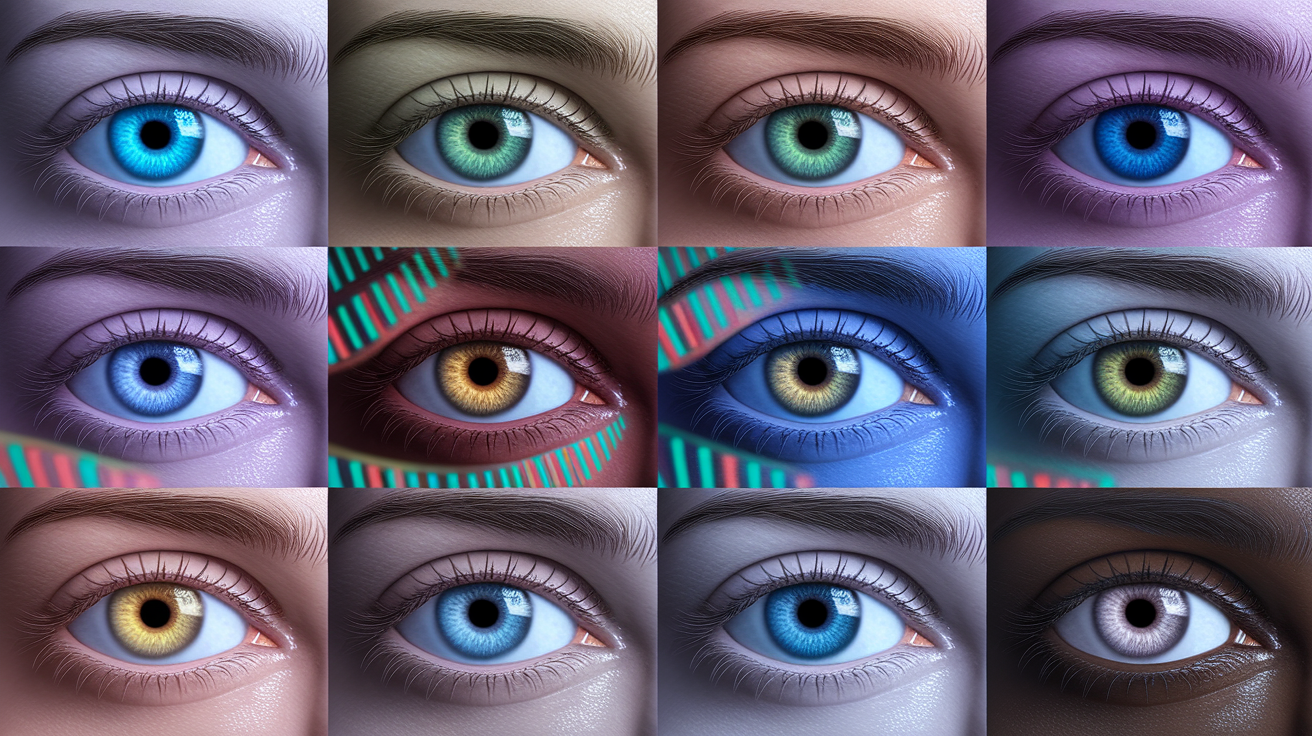
Eye color results from three forces working at once: genes, pigment, and how light behaves in the iris. While color names may seem straightforward, the biology is intricate, and cross-culturally, they are not even named similarly.
1. Melanin's Role
Melanin is the primary pigment determining how dark or light eyes appear. More melanin in the front of the iris produces brown to near-black eyes. Less melanin allows light to scatter, so eyes may appear blue, green or grey. Uneven spread makes hazel, brown flecks resting over a lighter base.
Minor melanin shifts alter tone with aging. Most babies begin with pale eyes that deepen in color over their initial years of life as melanin accumulates. Older adults might notice some lightening as pigment cells lose their pace.
In clinical work more than 50 shades of grey have been documented. That spectrum corresponds to variations in pigment as well as the manner in which the iris scatters light. There's not one 'right' color term, and different languages have different words.
2. Light Scattering
Blue/grey eyes are derived from light scattering in the stroma of the iris, not blue pigment. This is Rayleigh scattering (sometimes called Tyndall effect), the same reason the sky appears blue. If the stroma is fine and pigment-low, short wavelengths reflect back to the viewer.
Structure counts as much as pigment. Ice blue, steel grey or blue‑green colors appear when collagen fibers and holes in the stroma reflect light at different angles. In bright sun or LEDs, however, lighter eyes can appear sharper or cooler or even aqua-like. In shadow they appear more subdued and deeper.
Perception moves with the scene. A navy shirt, a white wall or golden hour light can push what others believe they see.
3. Genetic Influence
Eye color is actually polygenic. Old charts that considered blue to be a simple recessive are incorrect. Numerous genes impact pigment and structure, OCA2 a strong effect, with statistical models attributing 74% of variability from this dominant factor, 18% from additive genes, and 8% from one-of-a-kind environmental sources.
Broader estimates put genetics at 34% and environment, including age and light, at 66%. Green and amber typically result from particular variants or combinations at OCA2/HERC2 and additional genes. Inheritance can surprise families: two brown‑eyed parents may have a blue‑eyed child.
| Gene/region | Typical effect | Common outcomes |
|---|---|---|
| OCA2/HERC2 | Controls melanin in iris | Brown to blue range |
| SLC24A4, SLC45A2 | Melanin processing | Lighter shades, cool tones |
| TYR, TYRP1 | Pigment synthesis | Brown depth, hazel mix |
| IRIS structural loci | Stroma traits | Grey, blue‑grey nuance |
These scientists have traced the eye color terms in French and English back to the 1800s. Genomics, big data, AI and the CIE 1931 color space are now helping tie physical light to perceived color.
4. Iris Structure
The iris contains a front stroma of collagen and melanocytes, and a back pigment epithelium that is generally dark. Stroma density, fiber thickness and micro-folds influence light scattering and how cool tones emerge. Fine, sparse fibers lean blue, while denser, layered favor grey or green.
Specific elements such as crypts and radial streaks generate designs that appear unique up close. Heterochromia (two different irises) or sectoral heterochromia (a wedge of a different color) occur from local pigment or structural changes.
The last look is always a combination of anatomy and pigment, mediated by light and human perception.
A Spectrum of Cool Hues
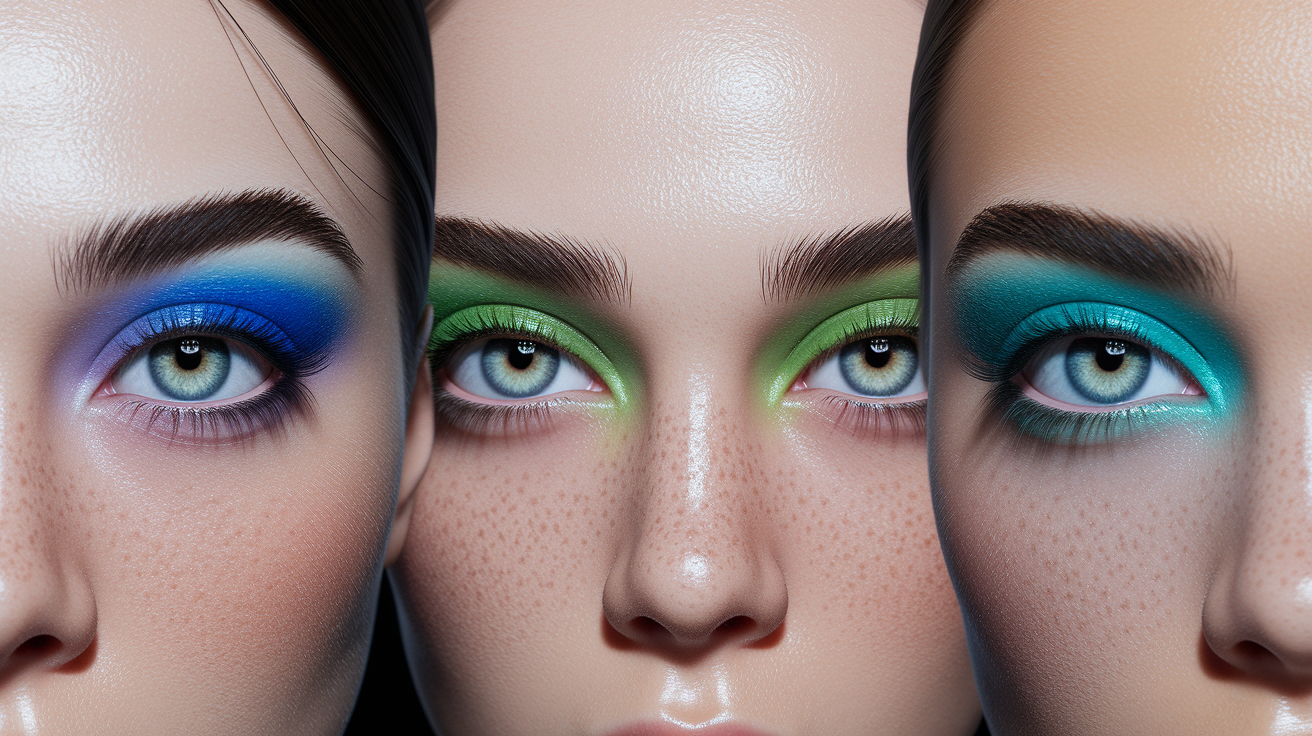
Cool colored eyes encompass blue, green and gray, all of which have their own slate of pale to deep tones. These colors are somewhat rare in many places but common in Eastern and Northern Europe. Their frosty appearance is due to Rayleigh scattering in the iris stroma, not blue or green pigment.
Less melanin equal more light scatter and a lighter, cooler eye. Some eyes blend cool and warm tones, such as gray with amber rings. Perception varies with light, outfits, and backdrop, so the same eyes can seem softer or sharper from hour to hour.
- Blue: baby blue, cornflower, denim, sapphire
- Green: mint, sea-green, olive, emerald, teal-tinted
- Gray: silver, slate, blue-gray, green-gray
Cool eyes tend to come across as exotic and bold since light reflection causes them to glimmer, particularly in photographs or sunny environments. Genetics lie behind it all; several genes influence melanin distribution, speckles and ring designs.
Lighting, makeup, and fashion steer what others see: cool clothing tones can echo the iris; warm tones can throw contrast and pull out gold flecks.
Cool Blue Eyes
Blue eyes vary from gentle baby blue to intense sapphire. The **color originates** from low melanin and short-wavelength light scattering in the stroma. It's that physics and not pigment that sets the blue.
Less common globally, more common among Europeans. In cool daylight (5500 K or so), blue eyes can appear bright and crystalline. Under warm indoor lighting they may turn more gray.
Navy, cobalt and charcoal clothing and taupe or cool brown or soft copper makeup can make blue eyes look sharp but not glaring. A matte base and defined lash line assist the iris in remaining the focus.
Mysterious Green
Green eyes are the rarest of them all. They result from moderate melanin plus a yellowish pigment (lipochrome), with Rayleigh scattering putting a cool cast on top of that. Some have golden or hazel flecks and the range goes from mint to olive to emerald with teal edges as well.
Hardly any of the world has actual green, so they read as weird. They photograph well too, which is why so many green-eyed actresses appear to dominate the screen.
Soft plum, moss or charcoal as clothing can reverberate green. In makeup, muted mauve, copper and moss liners highlight the green and retain equilibrium.
Elusive Grey
Uncommon and fascinating grey eyes, gliding from silver to blue-gray or green-gray depending on the scene. Minimal melanin and unique stromal architecture scatter light that can appear steel-cool in shade and subtly blue or green in sun.
Ambient light changes the whole game. Cloudy weathers might render them glacial, hour-glass might make the rim sunlit and reveal subtle swirls.
In photoshoots and fashion, grey eyes really pop against black, white, and slate – and close to soft pastels. Thin liner, cool taupe shadows and a clean brow frame let the shifting color be the story.
The Rarity Factor
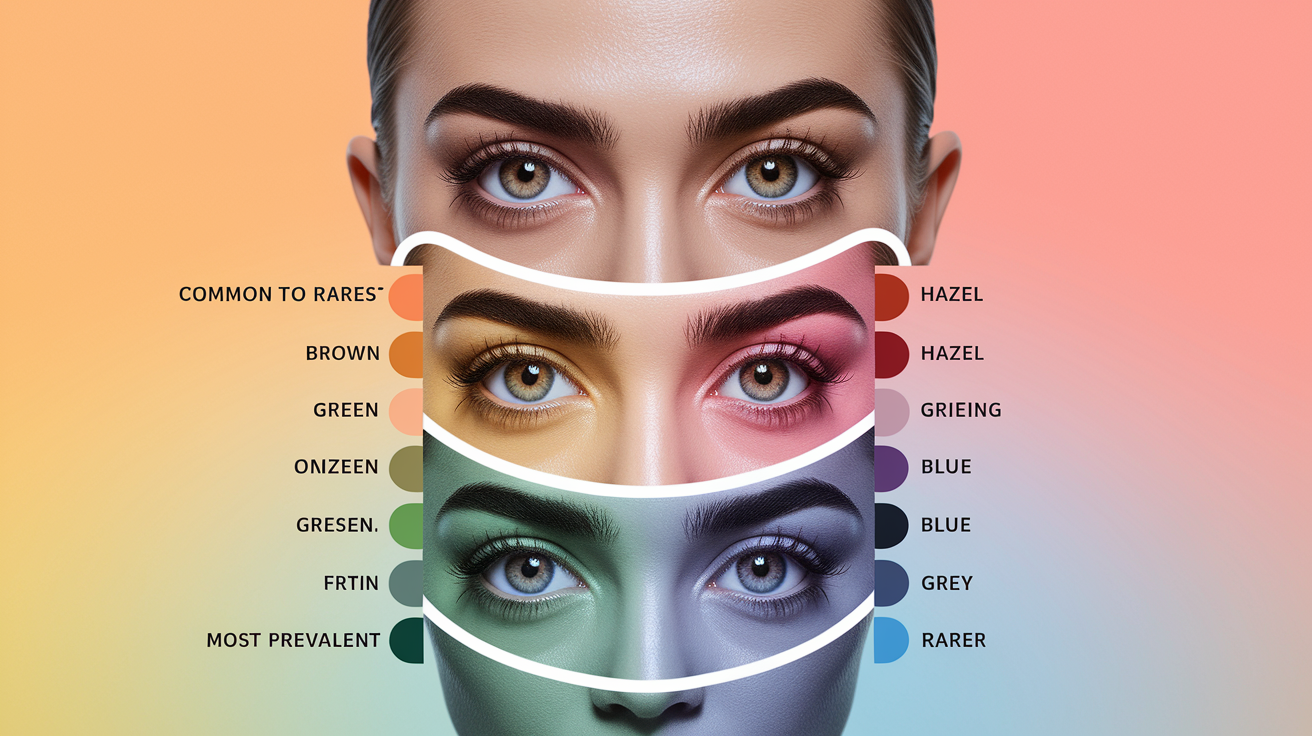
Cool-colored eyes, such as rare violet eyes, pop because they are rare in the world pool and genetically formed from pigment density and light scatter. While brown is the most common eye color, unique eye colors like **hazel eyes** and gray eyes stand out dramatically.
Common Colors
Brown eyes are the most common globally. High melanin in the iris and dominant gene patterns rock brown to the top of the chart, with around 79% of individuals worldwide.
Blue and hazel are far below brown but still common in areas of Europe. Blue is at 8–10% globally, hazel depends on location and is frequently combined with light brown in research.
Popular colors nonetheless range across dozens of hues. Light brown can appear golden in sun, and dark blue can read slate in shade. Undertones shift with lighting, age, even clothing.
- Brown: ~79% (global)
- Blue: ~8–10% (global)
- Hazel: ~5% (estimates vary by region)
Uncommon Shades
Green, gray, amber and true violet occupy the rare end. Green is found on around 2% of the world, more commonly in Northern, Central and Eastern Europe.
Gray is approximately 3% and frequently confused, because it may approach light blue – scientists say we still require more well-defined standards. Amber is around 5%, with a warm, golden color that can appear coppery in direct light.
Purple/red are the most uncommon and can happen naturally without contacts when the pigment is extremely low and there’s backscatter from visible blood vessels.
These shades arise from uncommon mixtures of melanin, the ratio of eumelanin and pheomelanin, and the manner in which the iris stroma scatters light. That's why gray, amber, and violet frequently appear mutable from environment to environment.
- Green (~2%): higher in parts of Europe; awesome, light scatter loads
- Gray (~3%): second-rarest after green; needs clearer classification
- Amber (~5%): uniform golden tone; third-rarest after green and gray
- Violet/Red (rarest): very low pigment; natural in rare cases
Unique Conditions
Heterochromia is the term used for two different eye colors, or segments of different colors in one eye. It may be genetic, post-injury or post in certain conditions.
Albinism may produce very light blue, gray or even red/pink eyes when pigment is scarce and blood vessels are visible. Certain diseases and medications change eye color over time, from rust rings to greenish casts, and these are rare.
These characteristics attract attention in all societies, frequently associated with rarity and attractiveness, even as their bearers consider them just natural to themselves.
How Perception Changes Color
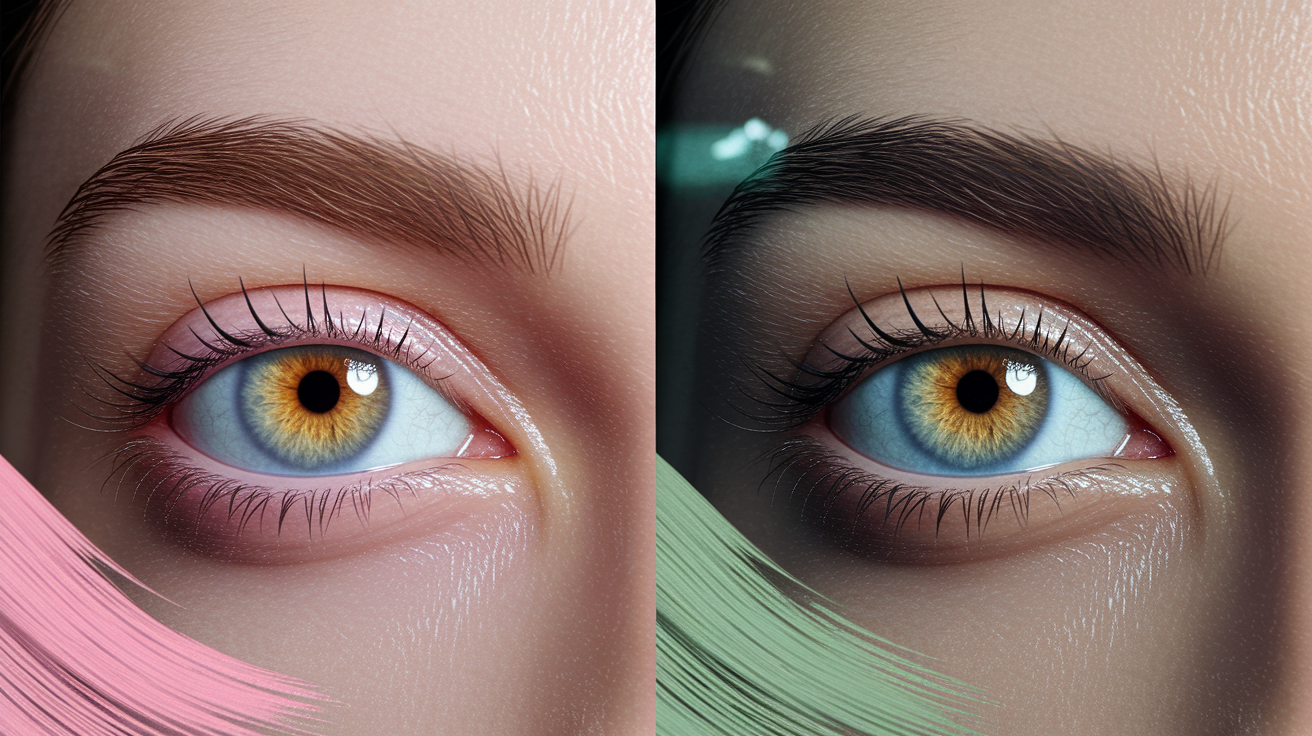
Cool colored eyes tend to seem like a different eye color at various times. What you perceive is influenced by lighting, environmental factors and health. Our eyes sample only 400–700 nm of the spectrum, and yet that sliver allows us to see millions of colors.
Perception is not static, changing along with our biology, our psychology, and the environment surrounding us. A raw side-by-side photo series of the identical pair of eyes in different settings can reveal the entire spectrum, and it reminds us to appreciate diversity instead of pursuing some singular 'correct' hue.
Lighting
Eye color can appear lighter or darker depending on intensity and type of light. Midday sun makes blue irises feel icy and green ones look clear, and fluorescent tubes can mute chroma and push a gray cast.
Hazy sunlight elevates yellows and reds because medium waves scatter more in the eye and the air, so warm tones emerge. In dark rooms, pupils dilate, the iris becomes smaller and the color reads darker and more muted.
Flash can wash detail, cause red-eye if it reflects off the retina or bias tone toward cooler or warmer whites. They look different depending on angle and diffuser.
Experiment with a window, shade, overcast sky, warm LED and cool fluorescent. Notice changes in lightness (L*), chroma (C*) and hue (h) as in CIE L_C_h for tracking the change with simple terms such as brighter, duller, or greener.
Surroundings
Clothes, makeup, backgrounds all nudge perception through contrast and complement. A teal scarf can make your hazel pull green. A slate wall can make blue seem steely.
Complementary hues intensify. For green eyes, go for soft reds such as terracotta or plum. For blue, warm browns, copper and camel add contrast that makes the iris pop. Neutral grays can crisp coolness without glare.
Colored contact lenses provide a temporary twist, from subtle shading to all-out coverage for special events or photo shoots. Go medical-grade, follow fit rules and keep 'em clean.
No fancy color theory needed—a simple color wheel helps. Choose near-complements to bring out brilliance, or analogous colors to maintain subtlety and flow.
Health and Age
Most babies begin blue or gray because melanin is low. As pigment develops, eyes can turn green, hazel, or brown within the first couple years.
Certain diseases and medications can alter pigmentation or induce sector shifts. Any sudden asymmetric change, pain or vision trouble needs to be checked by an eye care provider.
Aging can mellow chroma, more conspicuous in lighter eyes. It's nuance, but it's genuine. Regular screenings count. They protect vision and verify when a hue transition is typical.
Cultural Significance Worldwide
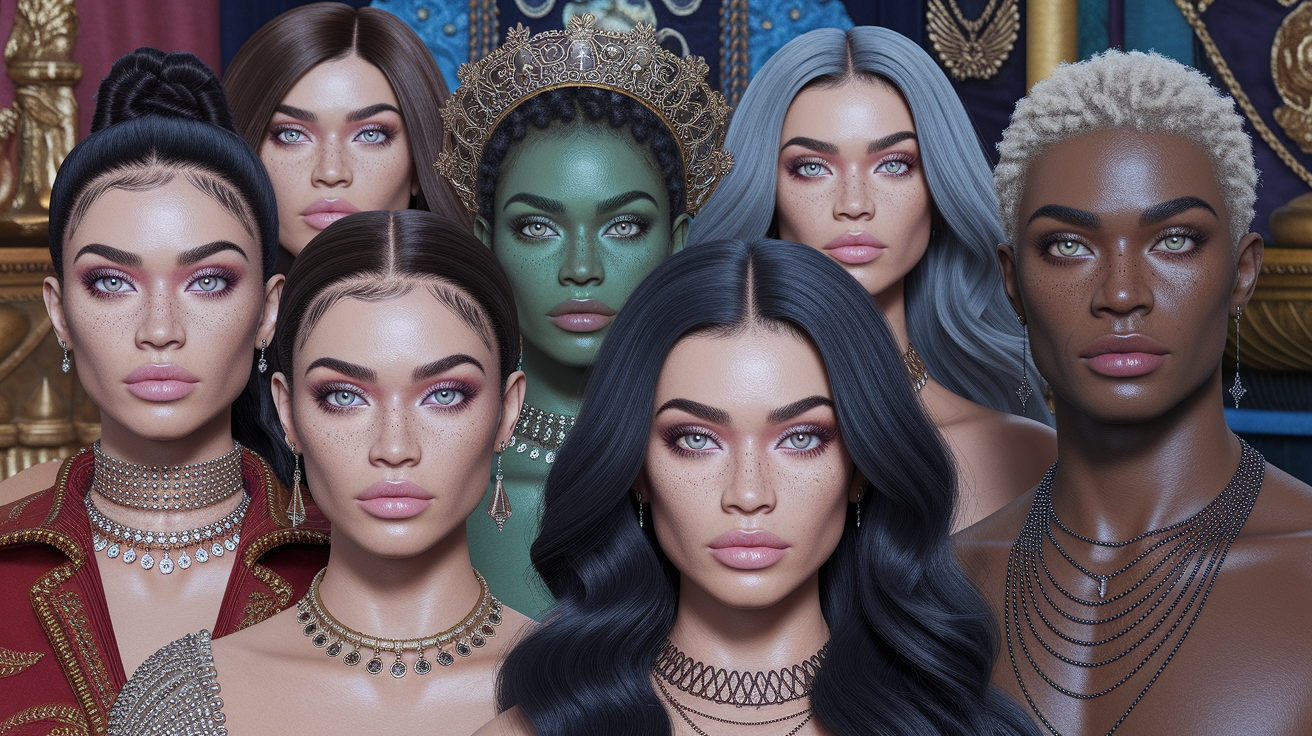
Cool colored eyes have a cultural significance that varies by location and era. What folks notice in blue, green, gray, or hazel eyes reveals a great deal about history, migration, beauty standards, and the narratives we inherit. The rarest eye colors often capture the imagination, showcasing how unique eye colors can embody stories of their own.
Through the ages, civilizations have associated eye color with folklore, destiny, and authority. Nordic sagas tell of sea-blue eyes as signs of bravery. Certain Mediterranean folktales caution that a pale gaze can throw or deflect the 'evil eye,' and thus amulets became common. In some parts of Central Asia, gray eyes had previously indicated someone a little bit mystical—honored and dreaded.
Anthropology and genetics support these stories with evidence. No single "blue gene," but multiple genes shape eye color, and that complexity has helped researchers trace migrations from Eurasia into Europe and beyond. Blue eyes, previously associated with European heritage, propagated through founder’s effects and selection in northern illumination. Green eyes, around 2% globally, remained scarce, so myths portrayed them as unique and destined.
Cool hues tend to read as exotic, beautiful, or mysterious, particularly where dark brown is the standard. In much of Asia, lighter eyes, including rare violet eyes, make you a star, and that shine of distinction drives fads—from colored contacts to permanent alteration surgeries. Media puts its own spin on it.
Close-up photos of a light iris against a dark lash line provide a high-contrast frame the camera adores. Casting directors know this: a gray-eyed lead can feel enigmatic on screen; a green-eyed villain can read sharp and unreadable; a hazel-eyed hero looks both warm and unusual. Fashion relies on the same effect. A blue iris renders cool-toned edits crisp, and green peepers alongside gold/copper makeup ignite editorials that linger.
They tie characteristics to colors, even though the research says "not demonstrated." In polls, blue eyes rate as serene, sincere, or reliable. Hazel, present in approximately 5% of the world's population and prevalent in regions of the Netherlands and the UK, tends to be labeled as flexible or inventive, showcasing how natural eye colors can influence perceptions.
A few cultures take it further, linking eyes to fortune or status. In some areas of Africa, lighter eyes have occasionally indicated privilege or exotic allure. Elsewhere, a baby born with light eyes attracts admiration and concern alike, and families mix pride with protective traditions.
Anthropology remarks that climate and light might influence distribution, but culture influences meaning, and meaning influences markets—cosmetics shades, lenses, photo styles that keep cool tones center stage.
Your Eyes and Your Health
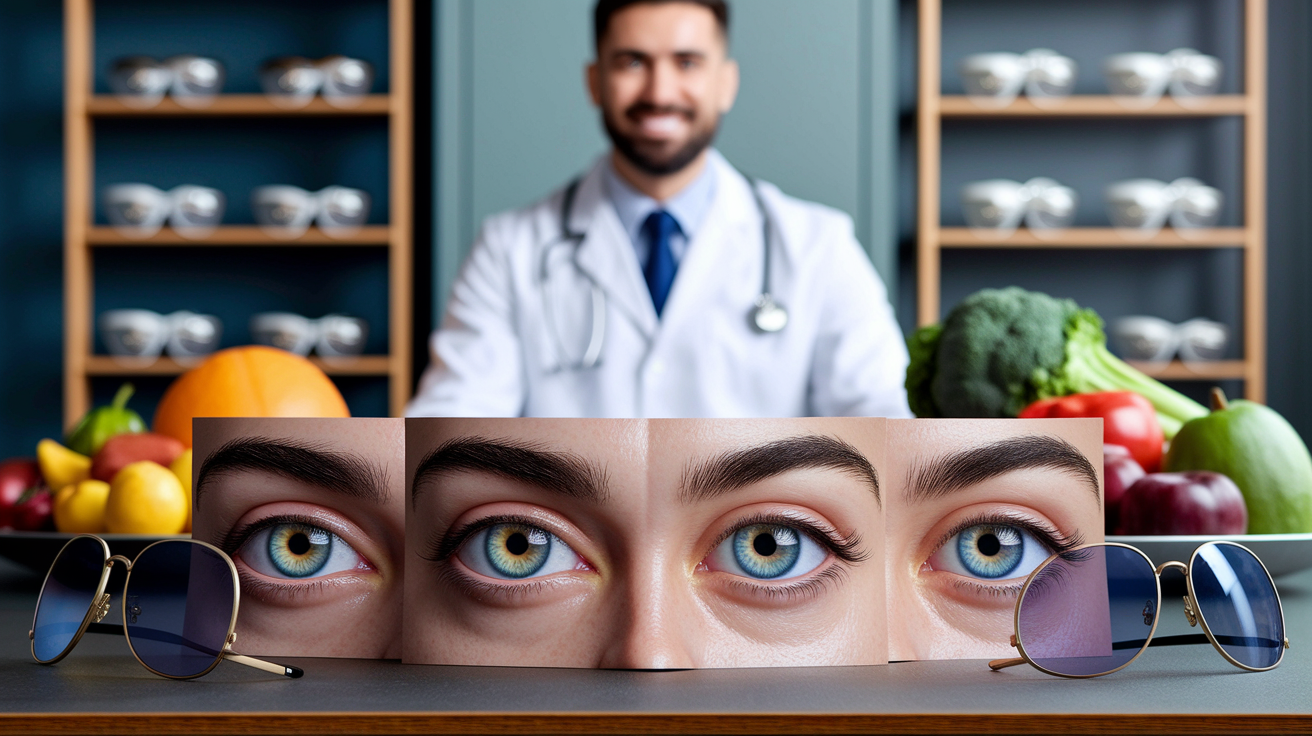
Cool-colored eyes look striking, but color can indicate how eyes manage light and danger. Melanin is the answer. More melanin (usually brown eyes) filters and blocks some UV. Less melanin (usually in blue, gray or green eyes) allows more light in, which can strain the retina and lens with prolonged exposure.
Eyes that are lighter are more susceptible to damage from glare and bright sun. They're twice as likely to develop age-related macular degeneration, a disease that damages central vision. Blue-eyed folks squint more in harsh daylight but perhaps see a shade better than others when light is limited. Darker eyes absorb more light, which can alleviate daytime glare.
Having said that, dark brown-eyed individuals should be aware that they're more prone to developing a vision-clouding condition earlier in life. Melanin certainly aids in this, but it doesn't make the eyes invincible to damage.
UV care counts for every shade. Sunglasses with 100% UVA/UVB protection reduce UV exposure that can accumulate in the cornea, lens, and retina. Wraparound frames minimize side glare, which assists light-sensitive blue or grey eyes on bright beaches, snowy summits, or expansive highways.
A broad-brim hat provides shade. Day to day, use artificial tears if screens dry your eyes, and follow the 20-20-20 rule to reduce strain. For sports or DIY, slip on some impact-rated goggles to shield you from dust and blunt blows.
Eye color may be a marker for risk outside the eye. Light-eyed people have higher risks of some skin cancers — basal cell and squamous cell carcinoma — probably due to common genetics with fair skin. Blue-eyed people are less prone to vitiligo, but a new study finds blue eyes with fair skin could increase the risk for type 1 diabetes.
These are trends, not destiny, but they can inform smarter screenings and habits, like sunscreen use and regular exams. Any uncommon eye color or sudden color change warrants a specialist visit. If a brown eye becomes hazy, or a new gray ring appears, or a green eye begins looking more yellow — it might indicate inflammation, iron overload, or lipid alterations.
Sudden anisocoria—one pupil larger than the other—can indicate nerve issues or other emergent conditions and requires immediate treatment. Keep your vision on track with annual eye exams — or more frequently if you have diabetes, high myopia or a family history of eye disease.
Consume a combination of leafy greens, omega-3 rich fish, nuts and colorful fruit to nourish the retina. Put on UV-blocking sunglasses all year long, even when it's cloudy.
Conclusion
Cool colored eyes catch fast attention, but the true magnet resides in the combination of genetics, illumination and temperament. There's a steel in a gray iris at times, then the warm soft blue in the sun. A green gaze can turn with a black tee. That mix provides each gaze with its own sharpness.
To make savvy care decisions, remember the fundamentals. UV light can damage eyes. A checkup once a year catches little things early. Dry air stings. Simple: a clean lens case can save you a trip to the clinic!
For a nifty experiment. Snap some pictures in soft light, harsh light and dusk light. Feel the difference. Need additional advice or interesting tales from other readers across the globe? Leave a comment or contribute your perspective.
Frequently Asked Questions
What makes eyes look "cool colored" like blue, gray, or green?
Cool colored eyes, such as blue and gray eyes, arise due to low melanin levels in the iris and light scattering in its layers. Rayleigh scattering causes these unique eye colors to show up, while green hues typically result from moderate melanin plus a yellow pigment known as lipochrome.
Which cool eye color is the rarest?
Green is considered one of the rarest eye colors in the world. Gray eyes are also classified as rare, while blue eye color is less rare but varies regionally due to hereditary factors and genes.
Can lighting make my eye color look different?
Yes. Sunlight, shadows, and the color of your clothing can all alter how unique eye colors appear. Cool lighting can intensify blue eye color or gray eyes, while warm lighting can evoke green hues or hazel colors.
Do cool eye colors affect vision or health?
Eye color variations, particularly those with lighter-colored irises, may be more sensitive to bright light and UV. UV-protective sunglasses are essential for maintaining eye health.
What genes determine cool eye colors?
Eye color is a polygenic trait influenced by rare eye color genes, particularly variants near the OCA2 and HERC2 genes, which strongly affect blue and green shades, leading to unique eye color variations even among relatives.
Are cool eye colors more common in certain regions?
Yes. Blue and gray eyes are more widespread throughout some of Europe. Green, a unique eye color that is excellently rare globally, is slightly more common in Northwestern Europe due to migration dispersing these rare eye colors.
Do different cultures view cool eye colors differently?
Yes. Different cultural significances influence our perception of unique eye colors. Why are blue or green eyes so prized in some cultures? Others appreciate brown eyes, which are the most common eye color.